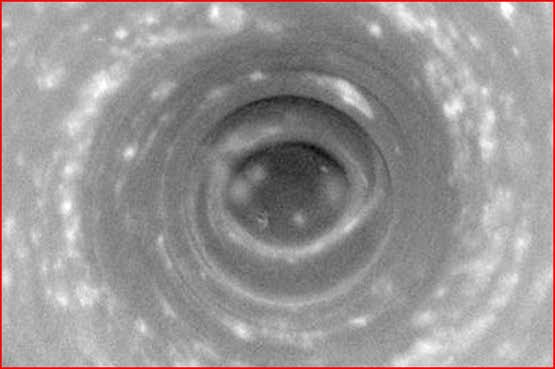- Photo Caption: ASA Sees into the Eye of a Monster Storm
on Saturn. Cassini image recorded November 9, 2006. Source: NASA/JPL/Space
Science Institute
-
- A gigantic vortex centered on Saturn's south pole has
sent astronomers scrambling for answers -- again. They remain unaware
that Wallace Thornhill had predicted this very "surprise."
-
- A recent image of Saturn's south polar region, taken
by the Cassini spacecraft, poses further mysteries for NASA investigators.
The cameras reveal a giant hurricane-like "storm" with a polar
eye, ringed by towering clouds.
-
- The "hurricane" spans a dark area inside a
thick, brighter ring of clouds. It is approximately 8,000 kilometers (5,000
miles) across, or two-thirds the diameter of Earth. "It looks like
a hurricane, but it doesn't behave like a hurricane," said Dr. Andrew
Ingersoll, a member of Cassini's imaging team at the California Institute
of Technology, Pasadena. "Whatever it is, we're going to focus on
the eye of this storm and find out why it's there."
-
- Since eye-wall clouds are a distinguishing feature of
hurricanes on Earth, NASA astronomers have been quick to draw a parallel,
though in their own words, the differences are noteworthy as well. As
the NASA news release states, "This giant Saturnian storm is apparently
different from hurricanes on Earth because it is locked to the pole and
does not drift around. Also, since Saturn is a gaseous planet, the storm
forms without an ocean at its base."
-
- But the release does not address the deeper enigma: hurricanes
typically originate in areas of solar heating, whereas by definition
a polar region is subject to the lowest levels of solar radiation.
-
- In its discussion of unanswered questions, the NASA release
can offer no explanation for the anomalous heating of Saturn's southern
pole. But for Wallace Thornhill, who has given considerable attention
to the Saturnian system, all of the indications of electrical activity
point to currents flowing into the south polar region. The consequence
of this focusing of current flow would be an energetic vortex penetrating
deep into its upper atmosphere. In this interpretation, the two spiral
arms noted by NASA are the telltale signature of the twin "Birkeland
currents" associated with vortex formation. (See "The 'Spiral
Galaxy' at Saturn's Pole" at http://www.holoscience.com/news.php?article=a0fu5dte)
-
- NASA's discussion, on the other hand, is limited to the
mechanics of wind and water circulation. As stated by Dr. Richard Achterberg,
a member of the Cassini team, "The winds decrease with height, and
the atmosphere is sinking, compressing and heating over the South Pole."
When isolated from any meaningful explanation of the phenomenon, such
language is in no way helpful!
-
- The release states that Saturn's polar "hurricane"
is "something never before seen on another planet." This language
is eerily familiar. In 1978, NASA's Pioneer Venus Orbiter revealed "one
of the more remarkable phenomena in the solar system" -- a double-eye
vortex at Venus' north pole. Almost 30 years later, when the ESA's Venus
Express detected a similar vortex at Venus' south pole, the organization
described it as a "peculiar double-eye vortex structure, never clearly
seen by any other Venusian mission before."
-
- In both the Saturnian and Venusian instances, the twin
spiraling components moved, but the vortex itself remains anchored to
the pole -- exactly as the electrical theorists would expect.
-
- Thornhill wrote in February 2005: "...[Saturn's
polar 'hot spot'] should be found on closer inspection to exhibit a similar
structure to the Venusian polar dipole. Its compactness is due to the
electromagnetic pinch effect where it enters Saturn's atmosphere. The
hot spot's behavior should be variable like that on Venus and correlated
with the appearance of Saturn's ring spokes, which are a visible manifestation
of a heightened equatorial discharge in that part of Saturn's Faraday
motor circuit. The Electric Universe also predicts, experimentum crucis,
that BOTH poles should be hot, not one hot and the other cold.
-
- ...Verification of any of these predictions should serve
notice that plasma cosmology and the electric model of stars is the cosmology
of the future."
|
